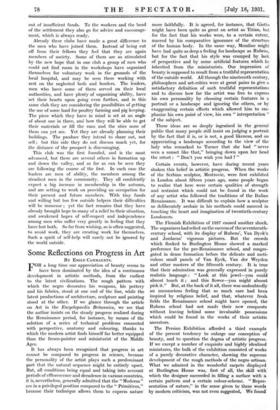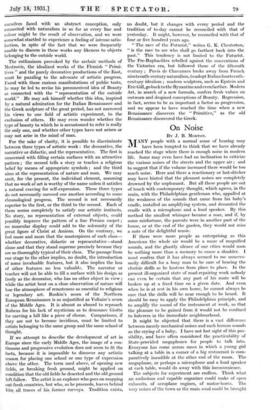Some Reflections on Progress in Art
BY EMILE CAMMAERTS.
It has always been recognized that progress in art cannot be compared to progress in science, because the personality of the artist plays such a predominant part that the natural sequence might be entirely upset. But, all conditions being equal and taking into account periods of efflorescence and decadence in various countries, it is, nevertheless, generally admitted that the "Moderns ". are in a privileged position compared to the " Primitives," because their technique allows them to express nature more faithfully. It is agreed, for instance, that Giotto might have been quite as great an artist as Titian, but for the fact that his works were, to a certain extent, marred by his comparative ignorance of the structure of the human body. In the same way, Memlinc might have had quite as deep a feeling for landscape as Rubens, but for the fact that his style was cramped by lack of perspective and by some artificial features which he inherited from the miniaturists. Our impression of beauty is supposed to result from a truthful representation of the outside world. All through the nineteenth century, philosophers and art-critics were at great pains to give a satisfactory definition of such truthful representations and to discuss how far the artist was free to express his own personality by choosing certain features in a portrait or a landscape and ignoring the others, or by exaggerating certain effects which allowed him to em- phasize his own point of view, his own " interpretation " of the subject.
These ideas are so deeply ingrained in the general public that many people still insist on judging a portrait by the fact that it is, or is not, a good likeness, and on appreciating a landscape according to the view of the lady who remarked to Turner that she had " never seen a sunset like that," bringing down upon her head the retort : " Don't you wish you had ? "
Certain events, however, have during 'recent years shaken this belief in artistic progress. When the works of the Serbian sculptor, Mestrovic, were first exhibited in London about fifteen years ago, some people began to realize that here were certain qualities of strength and restraint which could not be = found in the work of any artist who followed the traditions of the Italian Renaissance. It was difficult to explain how a sculptor so deliberately archaic in his methods could succeed in touching the heart and imagination of twentieth-century Londoners. .
The Flemish Exhibition of 1027 caused another shock. The organizers had relied on the success of the seventeenth- century school, with its display of Rubens', Van Dyck's and Jordaens' vigorous pictures. But the crowds which flocked to Burlington House showed a marked preference for the pre-Renaissance school, and congre- gated in dense formation before the delicate and meti- culous small panels of Van Eyck, Van der Weyden and other masters of the fifteenth century. It is true that their admiration was generally expressed in purely realistic language : " Look at this jewel—you could almost touch it ; and this flower—you might almost pick it." But, at the back of it all, there was undoubtedly an unconscious feeling that so much care had been inspired by religious belief, and that, whatever fresh fields the Renaissance school might have opened, the Rubens school had not made their new conquests without leaving behind some ' invaluable possessions which could be found in the works of their artistic ancestors.
The Persian Exhibition afforded a third example of the present tendency to enlarge our conception of beauty, and to question the dogma of artistic &ogress. If we except a number of exquisite and highly idealized miniatures, the bulk of the exhibition consisted of works of a purely decorative character, showing the supreme development of the rough methods of the negro artisan. What we admired in the wonderful carpets displayed at Burlington House was,' first of all, the skill • with which the designer succeeded in filling' a surface with a certain pattern and a certain colour-scheme. " Repre- sentation of nature," in the sense given to' these words by modern criticism, was not even Suggested, We found ourselves faced with an abstract conception, only connected with naturalism in so far as every line and colour might be the result of observation, and we were somewhat startled to experience a feeling of intense satis- faction, in spite of the fact that we were frequently unable to discern in these works any likeness to objects belonging to the outside world.
The 'enthusiasm provoked by the archaic methods of Mestrovic, the idealized works of the Flemish " Primi- tives " and the purely decorative productions of the East, must be puzzling to the advocate of artistic progress. Faced with these curious manifestations of public taste, he may be led to revise his preconceived idea of Beauty as connected with the " representation of the outside world." He may ask himself whether this idea, inspired by a natural admiration for the Italian Renaissance and the Greek sculpture of the great period, has not narrowed his views to one field of artistic experiment, to the exclusion of others. He may even wonder whether the type of beauty to which he is accustomed to refer is really the only one, and whether other types have not arisen or may not arise in the mind of man.
For the sake of clarity, it is possible to discriminate between three types of artistic work : the decorative, the narrative or didactic, and the representative. The first is concerned with filling certain surfaces with an attractive pattern ; the second tells a story or teaches a religious belief by means of appropriate symbols ; and the third aims at the representation of nature and man. We may omit, for the present, the individual element, assuming that no work of art is worthy of the name unless it satisfies a natural craving for self-expression. These three types do not necessarily succeed one another according to some chronological progress. The second is not necessarily superior to the first, or the third to the second. Each of them seems completely to satisfy our artistic instincts. No story, no representation of external objects, could possibly, improve the pattern of a fine Persian carpet ; no muscular display could add to the solemnity of the great figure of Christ at Amiens. On the contrary, we feel more and more that the masterpieces of each class— whether decorative, didactic or representative—stand. alone and that they stand supreme precisely because they are so thoroughly typical of their class. The passage from one stage to the other implies, no doubt, the introduction of some invaluable features, but it also implies the loss of other features no less valuably;. The narrator or teacher will not be able to fill a surface with his design as freely as the decorator, who has no other object in view ; while the artist bent on a close observation of nature will lose the atmosphere of remoteness so essential to religious or legendary art. Ruskin's scorn of the Northern European Renaissance is as unjustified as Voltaire's scorn of the Middle Ages. It is almost as absurd to reproach Rubens for his lack of mysticism as to denounce Giotto for carving a hill like a piece of cheese. Comparisons, if they are not to become invidious, must be limited to artists belonging to the same group and, the same school of thought.
If ,we attempt to describe the development of art in Europe since the early Middle Ages, the image of a con- tinuous and progressive evolution does not seem to fit the facts, because it is impossible to discover any artistic reason for placing one school or one type of expression above the other. The term used above, of opening new fields, or breaking fresh ground, might be applied on condition that the old fields be deserted and the old ground left, fallow. The artist is an explorer who goes on mapping outlresh countries, but who, as he proceeds, leaves behind him All ;traces of his , former surveys. Tradition exists, no doubt, but it changes with every period and the tradition of to-day cannot be reconciled with that of yesterday. It might, however, be reconciled with that of four or five hundred years ago.
" The- race of the Futurist," writes G. K. Chesterton,' " is the race to see who shall go farthest back into the past." This tendency is not limited to the Futurist. The Pre-Raphaelites rebelled against the conventions of the Victorian era, but followed those of the fifteenth century ; Puvis de Cheyennes broke away from French nineteenth-century naturalism, to adopt Italian fourteenth- century idealism ; modern sculptors, such as Epstein and Eric Gill, go back to the Byzantine and even farther. Modern Art, in search of a new formula, confers fresh values on outworn and despised conceptions of Beauty. Regression, in fact, seems to be as important a factor as progression, and we appear to have reached the time when a new Renaissance discovers the " Primitive," as the old Renaissance discovered the Greek.



































 Previous page
Previous page